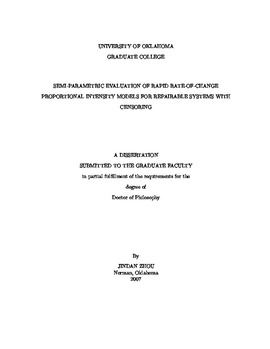| dc.contributor.advisor | Landers, Thomas L., | en_US |
| dc.contributor.author | Zhou, Jindan. | en_US |
| dc.date.accessioned | 2013-08-16T12:21:03Z | |
| dc.date.available | 2013-08-16T12:21:03Z | |
| dc.date.issued | 2007 | en_US |
| dc.identifier.uri | https://hdl.handle.net/11244/1322 | |
| dc.description.abstract | Keywords. repairable systems reliability, right-censoring, recurrent events, proportional intensity models, log-linear intensity function | en_US |
| dc.description.abstract | This research investigates the robustness of four leading proportional intensity (PI) models: PWP-gap time (PWP-GT), PWP-total time (PWP-TT), Andersen-Gill (AG), and Wei-Lin-Weissfeld (WLW), for right-censored recurrent failure event data that follow a Non-homogeneous Poisson Process (NHPP) with log-linear constant or increasing intensity function. The results are beneficial to practitioners in anticipating the more favorable applications domains and selecting appropriate PI models for monitoring failure trends and for decisions in preventive maintenance, service parts inventory, and repair versus replacement. The experimental design has incorporated four levels of censoring severity, three levels of sample size, and seven levels of shape parameter to evaluate these four proposed PI models. The effect of failure event count is also studied. The models of choice are the PWP-GT (for increasing rate of occurrence of failures and low event count) and AG (for constant rate of occurrence of failures), evaluated in terms of three robustness metrics: bias, mean absolute deviation, and mean squared error of covariate regression coefficients. The more favorable engineering application ranges are recommended. Robustness of the PWP-GT for the case of an underlying log-linear increasing intensity function tends to be sensitive to the failure event count. For lower failure counts (N ≤ 4), the PWP-GT proves to perform well for moderate to severe right-censoring (40% to 80% of units censored), constant and moderately increasing rates of occurrence of failure (log-linear NHPP shape parameter in the range of 0 ≤ theta ≤ 0.01), and small to large sample size (60 ≤ U ≤ 180). The AG model proves to outperform the PWP-TT and WLW for stationary process (HPP) across a wide range of right censorship (0% to 100%) and for sample size of 60 or more. A highly automated SAS macro proved to be a valuable tool for the research infrastructure in this and future studies. | en_US |
| dc.format.extent | xii, 88 leaves : | en_US |
| dc.subject | Maintenance. | en_US |
| dc.subject | Reliability (Engineering) Statistical methods. | en_US |
| dc.subject | Engineering, Industrial. | en_US |
| dc.subject | System failures (Engineering) | en_US |
| dc.title | Semi-parametric evaluation of rapid rate-of-change proportional intensity models for repairable systems with censoring. | en_US |
| dc.type | Thesis | en_US |
| dc.thesis.degree | Ph.D. | en_US |
| dc.thesis.degreeDiscipline | School of Industrial and Systems Engineering | en_US |
| dc.note | Source: Dissertation Abstracts International, Volume: 69-03, Section: B, page: 1876. | en_US |
| dc.note | Adviser: Thomas L. Landers. | en_US |
| ou.identifier | (UMI)AAI3308318 | en_US |
| ou.group | College of Engineering::School of Industrial and Systems Engineering | |
